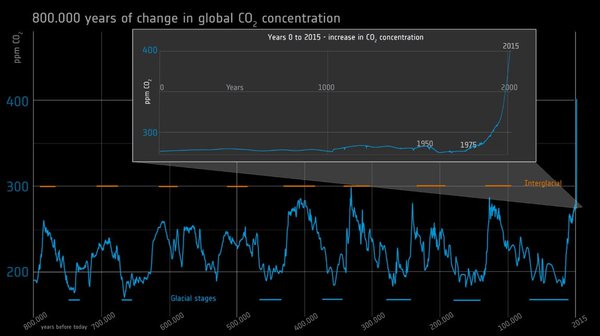The climate of a region is its predominant weather conditions, averaged over many years, whilst weather is the short-term change we see and experience on a daily basis.
Earth’s climate, the average conditions over all regions, has changed in the past due to natural processes. In the last million years it has settled into regular oscillations between warm periods and ice ages lasting tens of thousands of years, triggered by periodic shifts in the Earth’s orbit around the sun.

Over the last 800,000 years, concentrations of carbon dioxide in the atmosphere have fluctuated in response to glacial and interglacial periods, but have not exceeded 300 ppm. In the last century, however, due to industrialisation and fossil fuel combustion, carbon dioxide concentrations have increased at an unprecedented rate, and now exceed 400 ppm.
The Earth's climate is warming due to increasing concentrations of carbon dioxide and other greenhouse gases in the atmosphere. The Intergovernmental Panel on Climate Change concludes in its Special Report: Global Warming of 1.5°C, that “Human-induced warming reached approximately 1°C (above pre-industrial levels) in 2017, increasing at around 0.2°C per decade”. The amounts of snow and ice on the planet have diminished, and sea level rise is accelerating (WMO Statement on the State of the Global Climate, 2019).
Climate change is already having adverse effects on natural and human systems. These include negative impacts on terrestrial and marine ecosystems, reduced crop yields, and altered hydrological systems affecting water resources. Even our socio-economic systems, health and welfare are vulnerable to the cascading impacts of climate change and climate-related disasters (IPCC Fifth Assessment Report, 2014).
To tackle climate change, countries have agreed under the United Nations Framework Convention on Climate Change to stabilise greenhouse gas concentrations in the atmosphere at a level that prevents dangerous interference with the climate system. The Paris Agreement aims to keep global temperature rise well below 2 degrees Celsius above pre-industrial levels.
The Climate Change Initiative of the European Space Agency aims to increase the availability and use of global, satellite-based climate data records as a major contribution to the evidence base for climate change that drives international action. Source: ESA.